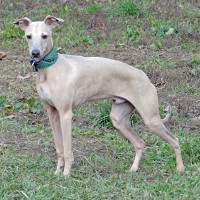 |
Levriero Italiano |
|
He is not recognized by the F.C.I. |
Origin |
Italy | |
Translation |
Francis Vandersteen |
| The Italian or Southern Greyhound is one of the oldest dog breeds. It is an ancient prey dog that helped man to hunt and survive, and has a working attitude, behaviors and strategies that differ markedly from all other dogs used in later activities, such as tracking, farm and den dogs. The Italian or southern sighthound has endured for centuries thanks to the socio-economic, environmental and rural conditions that have enabled and developed its use. Hunting out of necessity, which took place for centuries, and later as a typical pastime of medieval lords who hunted on horseback followed by greyhounds were the activities that directed the selection of the Greyhound in its form, which we now know. In the course of this functional selection made in particular centuries in search of a hare's point of view, the morphological traits that support function are stabilized by creating dogs with a structure adapted to hunting and optimized, equipped with appropriate bone angles, an excellent distribution of muscles adapted for a broad trot, perfect for covering a lot of distance at a very fast gallop, with a reinforced lung capacity and an extremely functional cardio-circulatory system to support these efforts. Let's not forget that the Greyhound was not the exclusive prerogative of a few well-to-do families, but its activity was also the garrison of those who hunted for their livelihood or loved the free-ranging or wild hare. Greyhound fundamentally evolved in southern Italy, as it presented the best environmental, climatic, orographic and, above all, prey abundance conditions. All these factors are in line with its activity and use: running and speed. This is how the Italian or Southern Greyhound came into being, in perfect condition for its limited function. A hunter by instinct, they move lightly and silently, and are able to withstand sustained effort, as they have great stamina, good breathing and toned, lean muscles. Their build is generally slightly elevated on the limbs, agile, slim with a deep, but not broad, sunken chest, retracted belly and strong, lean limbs. The Italian Greyhound has kept its morphological and behavioral characteristics unchanged throughout its thousand-year history. It is a dog inextricably linked to its masters or herd members. They are reserved by nature, wary of strangers and endowed with great sensitivity. Their affection is gentle, without excess, sometimes lapping up with a delicate touch of the tongue. Males range from 65 to 72 centimeters in height at the withers, with an ideal average of 70 centimeters; females vary from 60 to 68 centimeters in height at the withers, with an ideal average of 65 centimeters. The head is shaped like an elongated cone; the width of the skull is less than half the length of the head, making it very narrow. Large, deep-set eyes with a typically gentle expression, sometimes a little sad, almost melancholy. The muzzle is elongated, but with a strong jaw; prominent nose, tightly pressed lips, highly developed teeth, especially the long, strong canines. All colors and combinations are permitted: single-color, black, gray, slate, sand, light sand, reddish sand, anthracite sand, striped and fawn. All coats may or may not have white on head, chest and legs. |







 English (United Kingdom)
English (United Kingdom)